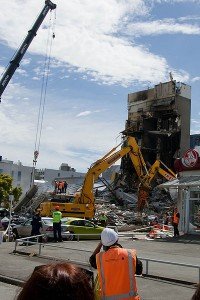New European research has raised the possibility of finding survivors in rubble — such as in the recent Christchurch and Japanese earthquakes — by detecting molecules in their breath, sweat and skin.
 A study, published September 12, in the Journal of Breath Research, examined flumes of air to create a preliminary profile of molecules that could indicate human activity in a disaster zone.
A study, published September 12, in the Journal of Breath Research, examined flumes of air to create a preliminary profile of molecules that could indicate human activity in a disaster zone.
It was notable for being the first of its kind to use human participants. Over five days, at six-hour intervals, eight participants entered a simulator of a collapsed glass-clad reinforced-concrete building, which was designed, built and tested by the researchers from Loughborough University, National Technical University of Athens, University of Babe-Bolyai and University of Dortmund.
A variety of sensors, positioned throughout the simulator, rapidly detected carbon dioxide and ammonia with high-sensitivity in the plumes of air that travelled through the constructed rubble, highlighting their effectiveness as potential indicators.
In addition to these molecules, a large number of volatile organic compounds were detected; acetone and isoprene being the most prominent potential markers.
When trapped within a void of a collapsed building, casualties release volatile metabolites — products of the body’s natural breakdown mechanisms — through their breath, skin and other bodily fluids, which can have complicated interactions with the building materials. These interactions change with conditions such as humidity, heat, and wind strength and direction, making the detection process much more difficult.
Interestingly, there was a marked decrease in ammonia levels when the participants were asleep; a finding the researchers could not explain and will investigate further, along with the build-up of acetone with increasing food withdrawal and the presence of detectable molecules in urine.
Co-author of the study, Professor Paul Thomas of Loughborough University, said, “This is the first scientific study on sensing systems that could detect trapped people. The development of a portable detection device based on metabolites of breath, sweat and skin could hold several advantages over current techniques.
“A device could be used in the field without laboratory support. It could monitor signs of life for prolonged periods and be deployed in large numbers, as opposed to a handful of dogs working – at risk to themselves and their handlers – for 20 minutes before needing extensive rest.”
An Institute of Physics spokesperson said, “As the first study of its kind, this preliminary work can be built upon to help prepare for future disasters such as those tragedies we’ve seen recently in Japan and New Zealand.”
The paper was part of research for a European Community project “Second Generation Locator for Urban Search and Rescue” Operations (SGL for USaR) aimed at solving critical problems following large scale structural collapses in towns and cities. The project combines chemical and physical sensors integration with the development of an open ICT platform for addressing mobility and time-critical requirements of USaR operations.